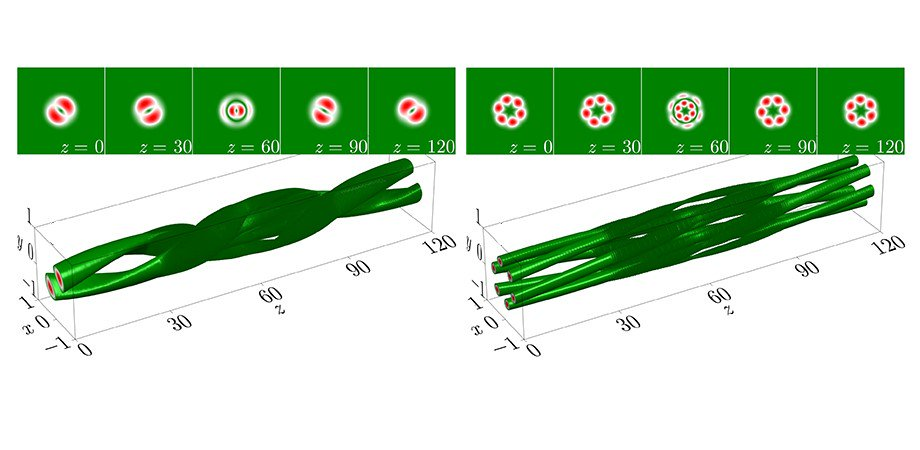Aug 12 2020
In the processing of optical information, the optical vortex has a highly crucial role to play. It works as an information carrier and enhances the channel capacity while providing an independent feature for analysis—other than intensity, polarization, path, and phase.
 Azimuthon transition between dipole and hexapole. Image Credit: Zhang et al., DOI: 10.1117/1.AP.2.4.046002.
Azimuthon transition between dipole and hexapole. Image Credit: Zhang et al., DOI: 10.1117/1.AP.2.4.046002.
Nonlinear optics can be used to offer a new degree of freedom to encode and encrypt optical information, with the help of vortex beams called azimuthons, which include an orbital angular momentum and can now be made to present a mutual conversion pattern called Rabi oscillation.
Rabi oscillation is a quantum effect dubbed after Isidor Rabi, who is a recipient of the 1944 Nobel Prize in Physics, and signifies a periodic motion—a type of flopping—between two distinct energy levels when an oscillatory driving field is present.
Moreover, this effect is studied in photonics, where it is possible to simulate the oscillatory driving field through a minor periodic longitudinal modulation of the refractive index change of the medium. Rabi oscillations have largely been investigated in the linear realm to date, but the most intriguing phenomena emerge only in nonlinear systems.
Although Azimuthons tend to present steady rotation upon propagation, they are usually unstable and typically disintegrate in the process of propagation. As suggested by a team of researchers headed by Yiqi Zhang from Xi’an Jiaotong University, a solution to that instability problem can be found in nonlinearity.
Recently, Zhang demonstrated weakly nonlinear waveguides that ensure the steady propagation of azimuthons. The study findings have been reported in Advanced Photonics.
Nonlinear, Multimodal Waveguide: From Rotation to Oscillation
The researchers identified particular needs for a weak nonlinearity: (1) when compared to the ambient refractive index, both the linear and nonlinear induced index changes are small; and (2) when compared to the induced linear index change, the nonlinear one is considerably smaller.
Theoretical analyses revealed a close association between the depth of the induced potential and the transverse size of the waveguide. This showed that it is possible to use multimode optical fibers to achieve a deep potential energy well that would also enable shallow modulation.
Zhang and colleagues took these elements into account and created a weakly nonlinear waveguide that is unequivocally multimode. They coupled different modes with various modal distributions. They achieved an azimuthally modulated vortex by inducing an amplitude modulation and a π-phase shift in one mode, and subsequently superposing the other.
The presence of a weak longitudinally periodic modulation and nonlinearity of the potential makes the azimuthally modulated vortex to rotate with a steady angular velocity in the process of propagation and to present Rabi oscillation (or flopping) between both the modes.
The propagating beam’s spatial symmetry was found to change periodically during the process. Coupled-mode theory proposes that Rabi oscillations are primarily influenced by the spatial symmetry and the longitudinal modulation strength of the superposed azimuthons.
In the absence of longitudinal modulation, each azimuthon rotates with a stable velocity, where its profile is conserved. However, a slight longitudinal modulation enables observing the mutual conversion of various azimuthons during the process of propagation—the Rabi oscillations.
Since our model supports higher order azimuthons with higher topological charges, there are many choices to select the orbital angular momentum carried by the light beams. However, the Rabi oscillation can only happen between azimuthons with certain profiles. We now have some ideas for how to overcome that limitation, so we’ll continue our investigations.
Yiqi Zhang, Study Senior Author and Associate Professor, School of Electronic Science and Engineering, Xi’an Jiaotong University
Varieties of Vortices
Apart from its potential to optimize optical information processing, the demonstration of Rabi oscillations of azimuthons offers better insights into the rotational dynamics of vortices and the intrinsic role played by nonlinearity in controlling those dynamics.
The researchers were fascinated by the manipulation of spatial field in nonlinear optical systems and add that the study results are crucial for prospective advances in the field of photonics, for instance, in topological insulators or helical waveguides.
In a wider sense, the understanding offered by the study could help achieve better insights into day-to-day phenomena like tornados and cyclones, or vortices that form in the wake of an airplane.
Journal Reference:
Jin, K., et al. (2020) Rabi oscillations of azimuthons in weakly nonlinear waveguides. Advanced Photonics. doi.org/10.1117/1.AP.2.4.046002.
Source: https://spie.org/?SSO=1